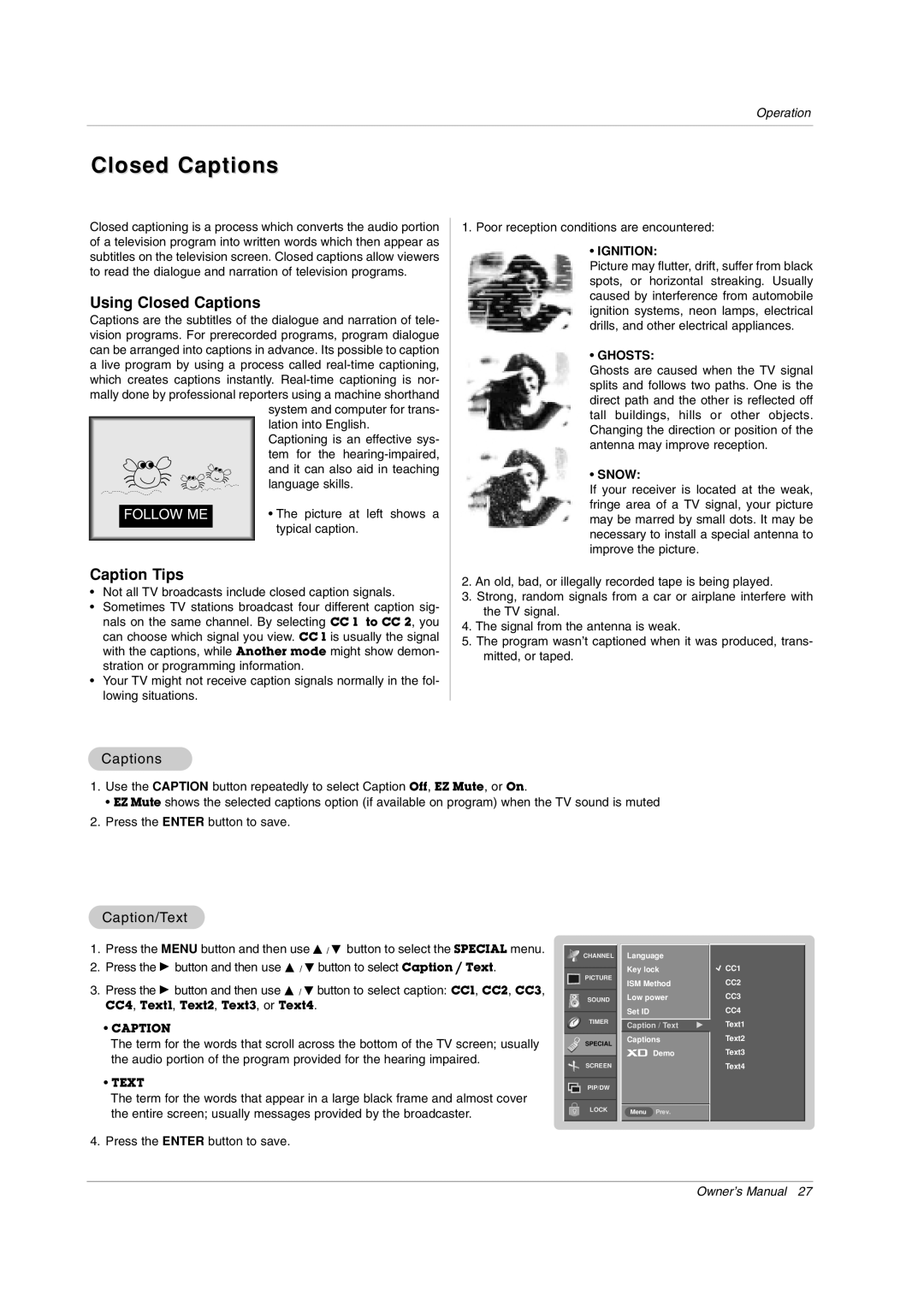
Operation
Closed Captions
Closed captioning is a process which converts the audio portion of a television program into written words which then appear as subtitles on the television screen. Closed captions allow viewers to read the dialogue and narration of television programs.
Using Closed Captions
Captions are the subtitles of the dialogue and narration of tele- vision programs. For prerecorded programs, program dialogue can be arranged into captions in advance. Its possible to caption a live program by using a process called
| system and computer for trans- |
| lation into English. |
| Captioning is an effective sys- |
| tem for the |
| and it can also aid in teaching |
| language skills. |
FOLLOW ME | • The picture at left shows a |
| typical caption. |
Caption Tips
•Not all TV broadcasts include closed caption signals.
•Sometimes TV stations broadcast four different caption sig- nals on the same channel. By selecting CC 1 to CC 2, you can choose which signal you view. CC 1 is usually the signal with the captions, while Another mode might show demon- stration or programming information.
•Your TV might not receive caption signals normally in the fol- lowing situations.
1.Poor reception conditions are encountered:
•IGNITION:
Picture may flutter, drift, suffer from black spots, or horizontal streaking. Usually caused by interference from automobile ignition systems, neon lamps, electrical drills, and other electrical appliances.
•GHOSTS:
Ghosts are caused when the TV signal splits and follows two paths. One is the direct path and the other is reflected off tall buildings, hills or other objects. Changing the direction or position of the antenna may improve reception.
•SNOW:
If your receiver is located at the weak, fringe area of a TV signal, your picture may be marred by small dots. It may be necessary to install a special antenna to improve the picture.
2.An old, bad, or illegally recorded tape is being played.
3.Strong, random signals from a car or airplane interfere with the TV signal.
4.The signal from the antenna is weak.
5.The program wasn’t captioned when it was produced, trans- mitted, or taped.
Captions
1.Use the CAPTION button repeatedly to select Caption Off, EZ Mute, or On.
• EZ Mute shows the selected captions option (if available on program) when the TV sound is muted
2.Press the ENTER button to save.
Caption/Text
1.Press the MENU button and then use D / E button to select the SPECIAL menu.
2.Press the G button and then use D / E button to select Caption / Text.
3.Press the G button and then use D / E button to select caption: CC1, CC2, CC3,
CC4, Text1, Text2, Text3, or Text4.
•CAPTION
The term for the words that scroll across the bottom of the TV screen; usually the audio portion of the program provided for the hearing impaired.
•TEXT
The term for the words that appear in a large black frame and almost cover the entire screen; usually messages provided by the broadcaster.
4.Press the ENTER button to save.
![]() CHANNEL
CHANNEL
PICTURE
SOUND
TIMER
![]() SPECIAL
SPECIAL
![]() SCREEN
SCREEN
PIP/DW
LOCK
Language |
|
| |
Key lock |
| CC1 | |
ISM Method |
| CC2 | |
Low power |
| CC3 | |
Set ID |
|
| CC4 |
Caption / Text | G | Text1 | |
Captions |
| Text2 | |
| Demo |
| Text3 |
|
|
| Text4 |
Menu | Prev. |
|
|
Owner’s Manual 27
